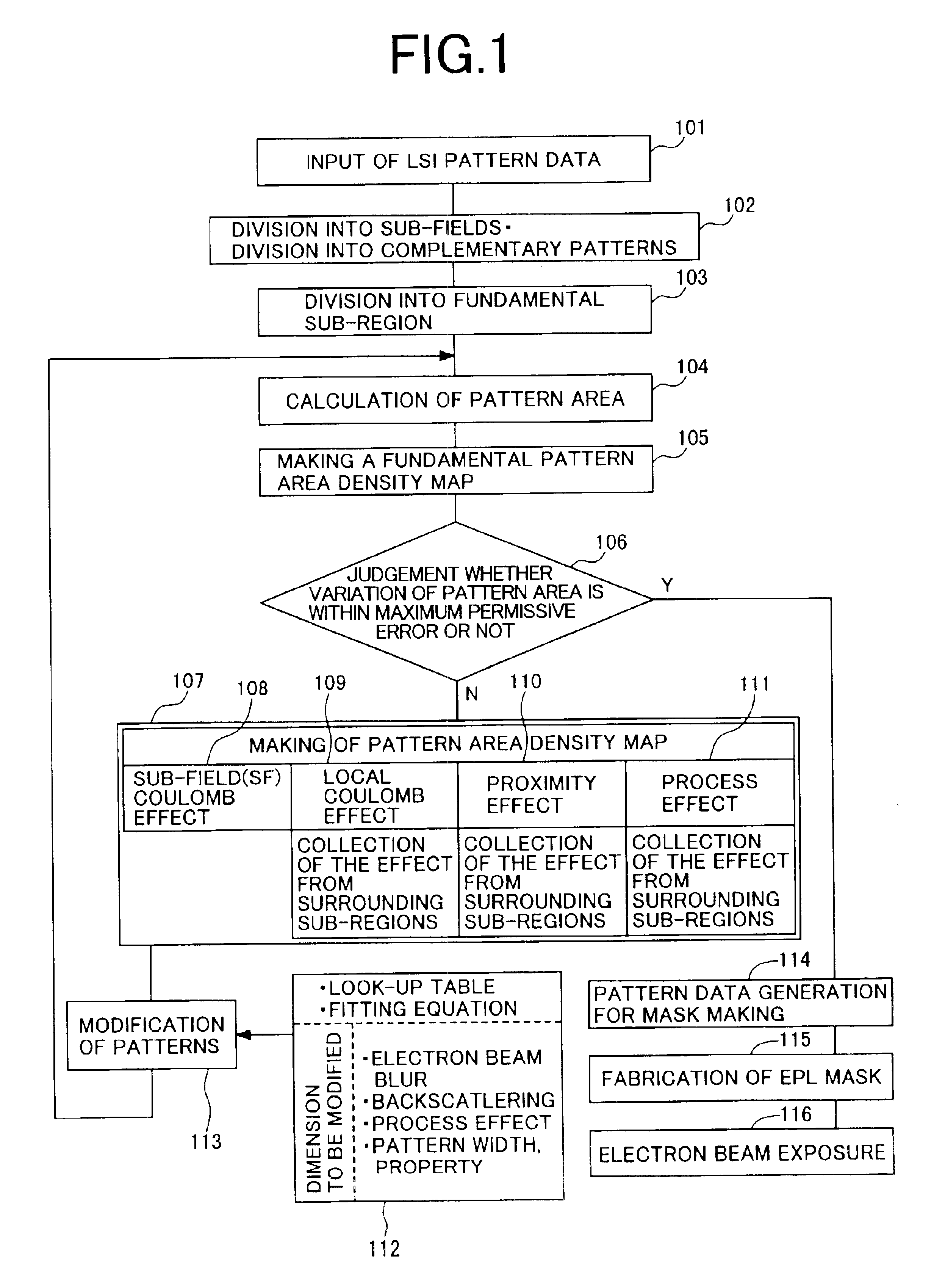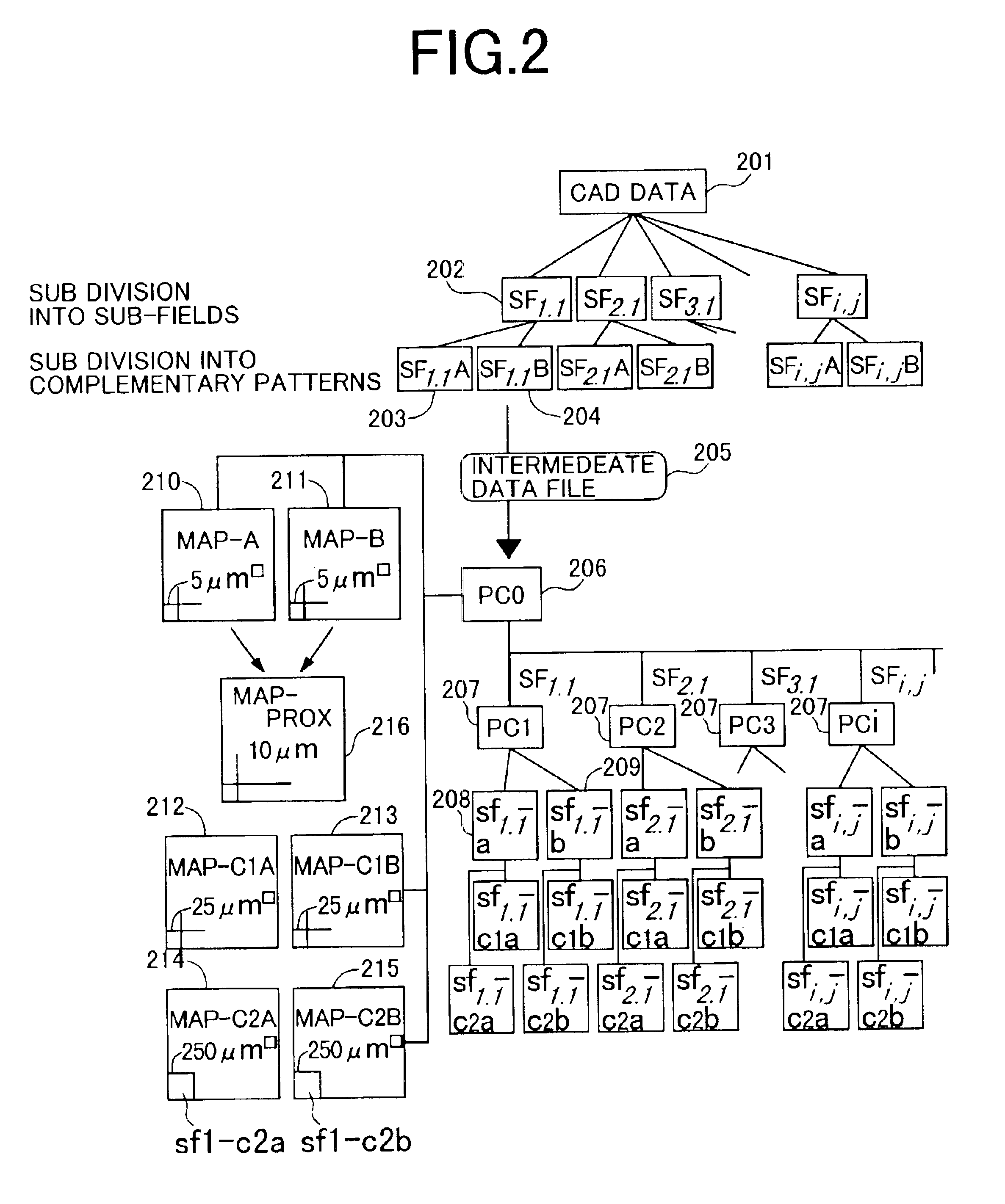Method for fabrication of patterns and semiconductor devices
- Summary
- Abstract
- Description
- Claims
- Application Information
AI Technical Summary
Benefits of technology
Problems solved by technology
Method used
Image
Examples
embodiment 1
Preferred embodiments of the invention are described hereinafter with reference to FIG. 1. FIG. 1 is a flow chart illustrating a method of forming patterns. Sections in rectangular shape are function blocks for data processing. First, LSI pattern data are provided as an input (101). Subsequently, as indicated by reference numeral 102, the pattern data is divided into units of sub-field (a region of a maximum size that can be subjected to projection by an electron beam at one time, equivalent to about 250 μm square on top of a wafer) that is dependent on an electron beam lithography system. Also, depending on LSI layers, division of the data into complementary patterns is executed as necessary. The order in which division of the pattern data into the sub-fields, and division of the pattern data into the complementary patterns are executed may be reversed. Thereafter, division of the pattern data into fundamental subdivided regions to serve as units for calculation of a pattern area d...
embodiment 2
FIGS. 2 and 3 are views illustrating processing in detail in the case of dividing pattern data into complementary patterns. FIG. 2 is a view illustrating a method of finding a pattern area density map. CAD data 201 completed by a layout design for an LSI of chip size 20 mm square is first divided into those in sub-fields 202, 250 μm square. The data after division comprises 6400 sets of data, in SF1,1 to SF80,80. Subsequently, each of the sub-field data is divided into two complementary data, 203, 204, that is, divided into SF1,1 A and SF1,1 B, in the case of, for example, SF1,1. Such division is implemented such that each of the complementary data does not include a doughnut-shaped pattern therein, and a pattern has a size with a ratio of the longitudinal dimension thereof to a transverse dimension thereof (aspect ratio) not exceeding 30. Processing up to this point is outputted as a function block to an intermediate data file 205. The format of the intermediate data file is prefer...
embodiment 3
FIG. 4 is a flow chart showing a still another embodiment, illustrating a method whereby errors due to variation in pattern area density accompanying modification of patterns are reduced by means of convergence calculation, and convergence calculation is further executed at high speed. With the present embodiment, there is described only a step of modifying patterns inside a fundamental subdivided-region by use of a pattern area density map.
There exist five rectangular patterns, patterns 402 to 406, inside a fundamental subdivided region 401 of size a, shown in FIG. 4. A shorter side of the respective rectangular patterns is referred to as w1 to w5, respectively, and a longer side thereof as h1 to h5 (not shown), respectively. The pattern 402 shares a side s1 with the pattern 403, and the pattern 405 lies so as to extend into an adjacent fundamental subdivided region. A line along which the pattern 405 is intersected by a demarcation line of the fundamental subdivided region 401 is ...
PUM
 Login to View More
Login to View More Abstract
Description
Claims
Application Information
 Login to View More
Login to View More - R&D
- Intellectual Property
- Life Sciences
- Materials
- Tech Scout
- Unparalleled Data Quality
- Higher Quality Content
- 60% Fewer Hallucinations
Browse by: Latest US Patents, China's latest patents, Technical Efficacy Thesaurus, Application Domain, Technology Topic, Popular Technical Reports.
© 2025 PatSnap. All rights reserved.Legal|Privacy policy|Modern Slavery Act Transparency Statement|Sitemap|About US| Contact US: help@patsnap.com



